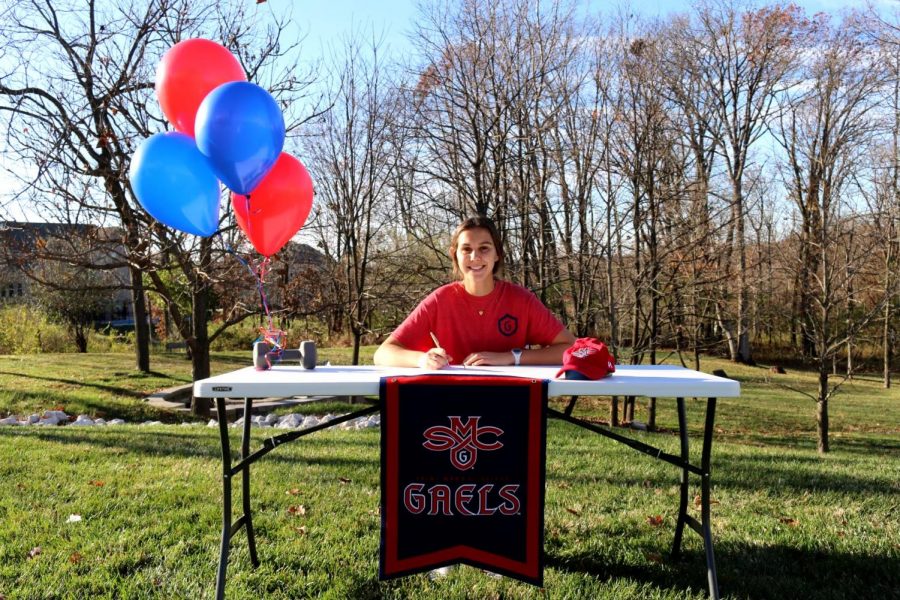The process to play college sports is a difficult one, with strict rules and limited windows of opportunity for interested students. With new cases topping 300,000 Jan. 8, the COVID-19 pandemic is the newest challenge for athletes.
Recruitment begins when a coach initiates a conversation at a game, practice or other event. From there, periods of limited communication, school visits and hard work both athletically and academically culminate in the student choosing their school.
“Normally you have these things called officials and you get to go visit a team and the coaches and basically live a day in the life of someone on the team at that school. You can take up to five of those and from there, you just keep talking to the coaches,” senior Katie Ferbet said.
After accepting an offer to row for St. Mary’s College of California, Ferbet will become one of 495,000 students to play sports at an National Collegiate Athletic Association (NCAA) college the next school year.
“Officials weren’t a thing anymore this year and that made the situation a lot more difficult because you couldn’t meet any coaches or anyone on the team in person. I flew out to a couple of colleges and even though I was at the school, I couldn’t talk to anyone on the team because that’s against NCAA rules,” Ferbet said.
The NCAA has strict guidelines surrounding the levels of contact coaches can have with potential recruits such as when visits and evaluations can occur and dead periods, when no communication is allowed.
“At the Division I level, they’ve had a dead period where coaches can’t leave campus and can’t have camps on campus. A lot of kids go to college camps to get on the radar of the college coaches, but those aren’t happening right now so that’s really changed the recruiting process,” Athletic Director Brian Kessler said, “Some of the Division II schools, Division III schools, NAIA [National Association of Intercollegiate Athletics] schools, junior colleges, they’re allowed to go out and recruit now, but they had a dead period for quite a bit of time as well.”
As the Athletic Director and a parent to two athletes, Kessler knows firsthand the struggles of trying to get recruited.
“My daughter is a softball player, she’s a junior, and we’re having a hard time getting her in front of coaches. I’ve got a son who plays college baseball, so I know how hard you have to work to be a college athlete. I know the things you have to give up to be a college athlete, I know that there’s a certain level of insecurity for college athletes because now you’re going to play big girl or big boy athletics and the whole world sees your stat line,” Kessler said.
Senior Nicholas Harms, who is looking to play baseball at a Division III school, is familiar with the hard work and emotions that come with the college recruiting process.
“It’s definitely nerve-wracking, especially talking to coaches for the first time. You don’t want to say the wrong thing, but most coaches are very nice and understanding,” Harms said. “If you don’t have a sibling who’s going through it like me, [coaches] kind of help you through everything that you need to do and they’ve been great with me.”
Harms also notes that restrictions due to the COVID-19 pandemic have created new difficulties for him.
“Generally, [during] the recruitment process for DIII, you go to a showcase during the summer of your senior year. The normal one is hosted by a company called Headfirst in New York and Florida, but they were all canceled due to COVID-19. I had to go all the way to Virginia for the showcase and it was only a fifth as many schools as first signed up for the other ones, so it kind of killed the interest I may have gotten at a normal showcase,” Harms said.
Harms has narrowed his school choices down to three and says that he is hopeful to be able to visit the schools in spring before he makes his final decision. Ferbet, who signed her national letter of intent back in November, says she felt a lot of relief when she made her final decision.
“It felt very nice to finally pick a college. The past few weeks leading up to [her decision] were very stressful, and once you pick a college, you can start to build the excitement about it, which was really fun. You can start meeting new people who are going to go there too,” Ferbet said.
Despite the lack of college visits, the limited communication, and the altered schedules that the pandemic created, students’ hard work came to a point as they signed with their colleges, a moment Kessler described with pride.
“For me, signing day is always a neat day because it’s the culmination of a lot of hard work and a lot of support from a lot of people. I’m just so proud of our kids for their work ethic and their determination and I think our kids are genuinely appreciative. Their high school coach, their principal, mom, dad, grandparents, teammates, they genuinely understand how hard they’ve worked to get them there, so it’s just a really really rewarding experience for us in the athletic department to see kids reach one of their goals,” Kessler said.



![Gazing up from the stage, junior Joseph McCurdy who played Peter Pan in the school play, Lost Girl, sits next to senior Juliana Rogers, who plays Wendy Darling, during a theater rehearsal. McCurdy’s passion for theater began when he observed a West High production in middle school. “I've been in the high school theater program since I was a freshman. I've always loved theater, but [what prompted me to join] was [when] I went to see [a performance here] when I was in middle school, and it was super cool,” McCurdy said.](https://pwestpathfinder.com/wp-content/uploads/2025/11/IMG_6535-1200x798.jpeg)

![Standing tall, stacked in a precise formation, the cheer team strikes a signature pose during halftime on Sept. 12 at the varsity football game. Nearly a month after this performance, the cheer team performed at the Missouri Cheerleading Coaches Association (MCCA) regional competition on Oct. 4, 2025. “We've all come [to] work together a lot more,” sophomore Elyssa Philippi said. “We're a lot closer than we were [earlier in the season] and going to state has made us closer [in] trying to work with each other, learn [new] skills and make our team better.”](https://pwestpathfinder.com/wp-content/uploads/2025/11/DSC5139-1.jpg)
![Handing out candy to excited trunk-or-treaters, President of the United Nations Children’s Fund club and junior Sara Ashok represents that group. Ashok was eager to participate in this event for multiple reasons. “I really wanted to be a part of the event because I get to help create memories for kids and spend time with my friends, spreading the things [I'm passionate about],” Ashok said.](https://pwestpathfinder.com/wp-content/uploads/2025/11/DSC_8648-1-1200x800.jpg)

![Smiling in a sea of Longhorns, Fox 2 reporter Ty Hawkins joins junior Darren Young during the morning Oct. 3 pep rally. The last time West was featured in this segment was 2011. “[I hope people see this and think] if you come to [Parkway] West, you will have the time of your life because there are so many fun activities to do that make it feel like you belong here. I was surprised so many people attended, but it was a lot of fun,” Young said.](https://pwestpathfinder.com/wp-content/uploads/2025/10/Edited2-1200x798.jpg)
![West High seniors and families listen as a representative of The Scholarship Foundation of St. Louis, Teresa Steinkamp, leads a Free Application for Federal Student Aid (FAFSA) workshop. This session, held in the library, provided guidance on financial aid, scholarships and student loan options. “This event is very beneficial for any seniors who are applying to or considering applying to colleges after high school [because] the cost of college is on the rise for seniors and parents,” college and career counselor Chris Lorenz said.](https://pwestpathfinder.com/wp-content/uploads/2025/09/DSC_4478-1200x778.jpg)
![Senior Kamori Berry walks across the field during halftime at the Homecoming football game on Sept. 12. During the pep assembly earlier that day, she was pronounced Homecoming Queen. “I thought it was nice that the crowd [started] cheering right away. I know [my friends] were really excited for me, and my family was happy because typically non-white people don't win,” Berry said.](https://pwestpathfinder.com/wp-content/uploads/2025/09/DSC7046-Enhanced-NR-1200x798.jpg)


